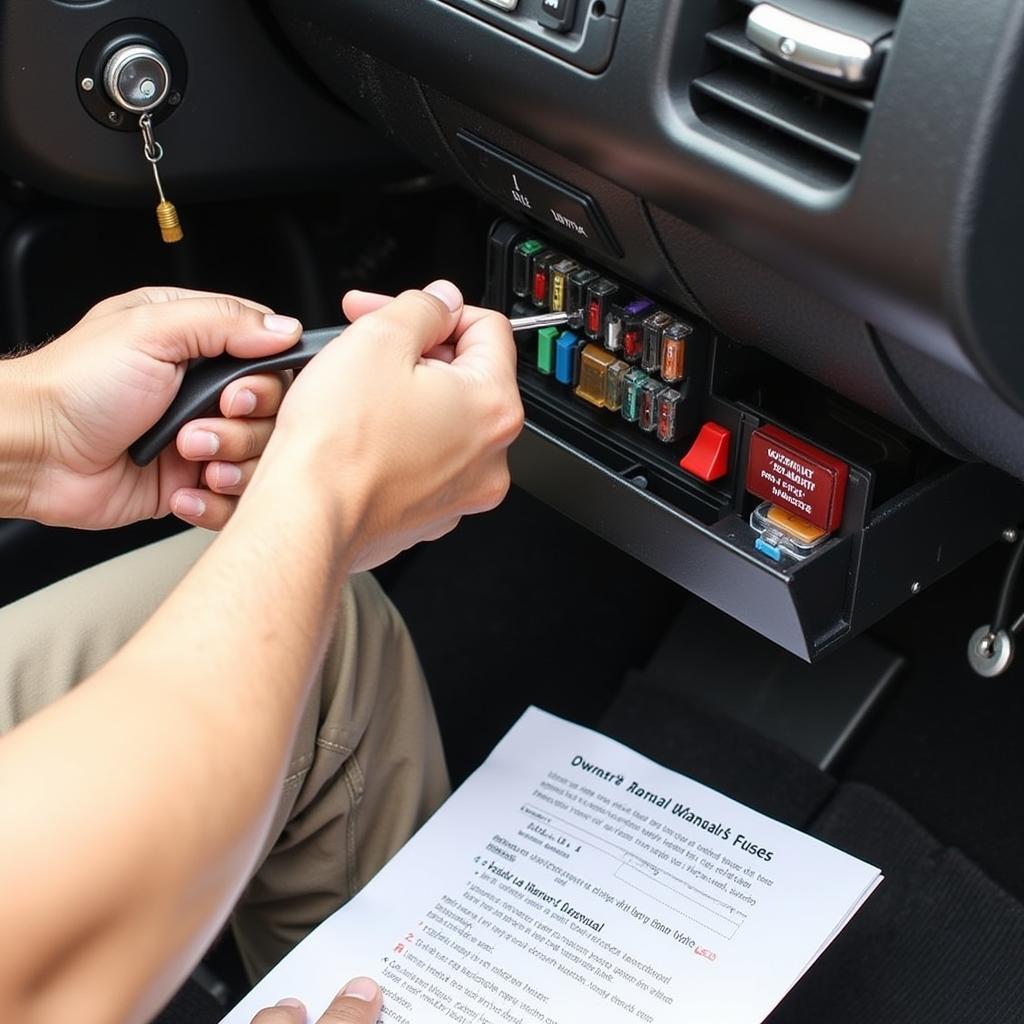Troubleshooting electrical issues in your car can be frustrating. From a dead battery to flickering headlights, these problems can range from minor inconveniences to significant safety hazards. This guide will empower you with the knowledge and tools to diagnose and fix common electrical problems in cars, saving you time and money.
Understanding Your Car’s Electrical System
Before diving into How To Fix Electrical Problems In Cars, it’s crucial to understand the basics. Your car’s electrical system is a complex network of components, including the battery, alternator, starter, fuses, relays, and wiring. These components work together to power everything from the engine and lights to the radio and power windows. A problem with any of these components can cause a cascade of issues.
Common Electrical Problems and Solutions
Many electrical issues can be diagnosed and fixed with some basic tools and a little know-how. Let’s explore some of the most common car electrical problems and how to troubleshoot them.
Dead Battery
A dead battery is perhaps the most frequent electrical problem car owners face. Symptoms include the inability to start the car, dim headlights, and a clicking sound when turning the key. Check the battery terminals for corrosion. Clean them with a wire brush and baking soda solution if necessary. If the terminals are clean, test the battery with a multimeter. If the voltage is low, you’ll likely need a new battery.
Blown Fuses
Fuses are designed to protect your car’s electrical system from power surges. When a fuse blows, the circuit it protects is broken, preventing damage to more expensive components. Locate your car’s fuse box (usually under the dashboard or hood) and consult the owner’s manual to identify the correct fuse. A blown fuse will have a broken filament. Replace it with a new fuse of the same amperage.
Faulty Alternator
The alternator recharges the battery while the engine is running. A faulty alternator can lead to a dead battery and other electrical issues. Symptoms include dim headlights, flickering dashboard lights, and a whining sound from the engine compartment. Test the alternator’s output voltage with a multimeter. If the voltage is low, the alternator needs replacing. Similar to cars worth fixing and keeping, assessing the cost of alternator replacement is crucial.
Malfunctioning Starter
The starter motor cranks the engine to start it. A bad starter can prevent your car from starting altogether. Symptoms include a clicking sound when turning the key, or the engine not turning over at all. You can test the starter by tapping it gently with a hammer while someone tries to start the car. If the car starts, the starter likely needs replacing. Just as you might consider a car breaker fix for other parts, a new starter may be needed.
Wiring Problems
Loose, corroded, or damaged wiring can cause a variety of electrical problems. Inspect the wiring harnesses for any visible damage. Look for frayed wires, loose connections, or signs of corrosion. Repair or replace any damaged wiring. This process can be challenging, especially with intricate electrical systems. For more complex electrical issues, like those potentially found in a fixing a flood title car, consulting a professional is recommended.
Electrical Shorts
An electrical short occurs when a wire with damaged insulation comes into contact with another wire or a metal part of the car. This can cause fuses to blow, components to malfunction, and even fires. Locating and repairing shorts can be complex and often requires specialized tools and knowledge.
“Regularly inspecting your car’s electrical system is key to preventing costly repairs,” says John Smith, Automotive Electrical Engineer at Auto Electric Solutions. “A simple visual check can often identify potential problems before they become major headaches.”
 Checking Car Fuses in the Fuse Box
Checking Car Fuses in the Fuse Box
How to Use a Multimeter for Diagnosis
A multimeter is an essential tool for diagnosing electrical problems. It can measure voltage, current, and resistance, helping you pinpoint the source of the issue. Learn how to use a multimeter properly to accurately test various components.
“Understanding how to use a multimeter can empower car owners to diagnose many electrical problems themselves,” adds Jane Doe, Lead Technician at Auto Repair Pro. “This can save both time and money in the long run.”
Conclusion
Understanding how to fix electrical problems in cars can be invaluable. By familiarizing yourself with the common issues outlined in this guide and learning basic troubleshooting techniques, you can save yourself from expensive repair bills and keep your car running smoothly. For further assistance, feel free to connect with us. Contact AutoTipPro at +1 (641) 206-8880, or visit our office at 500 N St Mary’s St, San Antonio, TX 78205, United States. Knowing whether do infinity cars cost as much as bmw to fix can also influence your maintenance decisions.
 Car Electrical Diagnostic Tools: Multimeter and Test Light
Car Electrical Diagnostic Tools: Multimeter and Test Light
FAQ
- What are the signs of a bad alternator? Dim headlights, flickering dashboard lights, and a whining sound from the engine compartment are common signs.
- How do I check a fuse? Visually inspect the fuse for a broken filament or use a multimeter to test for continuity.
- What causes a car battery to die? A faulty alternator, leaving lights on, extreme temperatures, or an old battery are common causes.
- Can I fix a damaged wiring harness myself? Minor repairs might be possible, but for extensive damage, consult a professional.
- What should I do if I suspect an electrical short? Disconnect the battery immediately and seek professional help.
- What are some essential tools for diagnosing car electrical problems? A multimeter, test light, and wiring diagrams are helpful tools.
- How often should I check my car’s electrical system? A visual inspection every few months and a more thorough check annually are recommended.






Leave a Reply